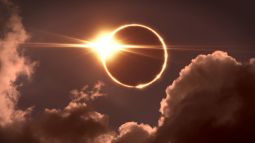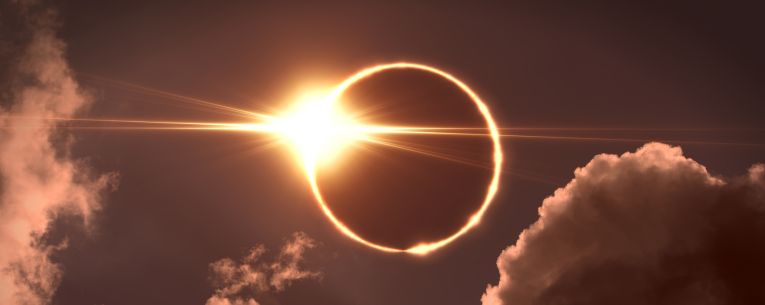The bright day dims. Birds stop singing. The air takes on a sudden chill. Strange bands of light ripple across the ground.
The experience of a total solar eclipse—when the moon completely blots out the sun during the day—is otherworldly and unforgettable. If you’ve never seen this phenomenon, 2024 is the year to do it.
April 8, 2024 will be the last chance to see a total eclipse in the U.S. for 20 years. (The next total solar eclipse seen from the contiguous United States will be on Aug. 23, 2044.1) People in a narrow band across Mexico, the U.S. and Canada will be able to see this remarkable astronomical event. Curious to see it yourself? Time to start planning an eclipse trip!
Why travel to see a total solar eclipse?
On August 21, 2017, a total solar eclipse could be seen in a 70-mile-wide band across the U.S., from Oregon to South Carolina. Most people outside that viewing area were content to see the partial eclipse, which was visible throughout the United States plus parts of South America, Africa, Asia, and Europe.2 Witnesses may remember crescent-shaped shadows and the dramatic dimming of the sun.
But a total eclipse, when all solar emissions vanish for a few minutes, is a completely different experience, says astronomy writer Bob Berman. Impossible to fully capture in a video or photo, it is “the most powerful, gorgeous, and even life-altering of all celestial phenomena… Flames of nuclear fire visibly erupt like geysers from the sun’s edge. Shimmering dark lines cover the ground.”3
Berman explains that in any given place on earth, a totality occurs just once every 375 years. So if you want to experience a complete solar eclipse, you can’t just sit back and wait for one to be visible from your hometown (unless you’re lucky enough to live in the path of the 2024 totality).
Where is the best place to see the 2024 eclipse?
The first thing to do is look at a map of the 2024 solar eclipse path of totality. The green centerline indicates where the totality lasts the longest. The total eclipse can be seen anywhere within the yellow lines. Outside of those lines, it’s a partial eclipse.
Several major American cities lie within (or partially within) the band of the total eclipse. These include Austin and Dallas, TX; Little Rock, AR; Indianapolis, IN; Cleveland, OH; Buffalo, NY; and Burlington, VT. Here’s a list of cities where you can see the 2024 total eclipse.
However, location isn’t the only factor to consider. The visibility of the eclipse depends entirely on the weather at your destination. If the clouds roll in, you may not see a thing. Long-term weather data suggests that the best place to see the 2024 eclipse will be in Mexico or Texas, which have the best chance of clear skies in April.4 Outside magazine has a few recommendations, including:
- Mazatlán, Mexico, a beautiful beach resort on the Pacific coast
- Durango, Mexico, known for historic colonial architecture
- Kerrville, TX, a town in the Hill Country
- Sandusky, OH, where lake-effect weather improves chances of clear skies
A note: If you’re planning to visit Mexico for the eclipse, it’s wise to check State Department travel advisories for your specific destination.
2024 eclipse travel tips
- Consider joining a tour. Having an expert guide can enrich your eclipse experience. The Griffith Observatory is organizing a few eclipse-viewing tours led by staff astronomers. The 8-day México Total Solar Eclipse Adventure includes trips to ancient ruins and museums in México City, a tour of Aztec pyramids in Teotihuacán, and a visit to a mezcal maker.
- Book well in advance. Accommodations in many eclipse destinations are already sold out. That means you shouldn’t dawdle if you’re thinking about planning a trip! If your intended destination is too popular, consider staying outside the path of totality and then driving to a spot on the center line.
- Choose a larger town or city. As Astronomy magazine points out, “a town of 10,000 is much more likely to have event-related problems than a city of 75,000. Traffic will be one of the primary issues; small communities with one main road may suffer hours of gridlock.”
- Choose a destination that offers other things to do. If bad weather makes your eclipse viewing a washout, you’ll want some backup plans to make the trip worthwhile. In Austin, you can watch the famous nightly bat flight and catch some live music. (Read our destination guide to Austin.) Indianapolis is home to a renowned zoo, art museums, and the Indianapolis Motor Speedway Museum.
- Don’t forget your eclipse-viewing glasses! It’s crucial to protect your eyes when you’re looking at an eclipse. Here’s what NASA says: “Except during the brief total phase of a total solar eclipse, when the Moon completely blocks the Sun’s bright face, it is not safe to look directly at the Sun without specialized eye protection for solar viewing. Viewing any part of the bright Sun through a camera lens, binoculars, or a telescope without a special-purpose solar filter secured over the front of the optics will instantly cause severe eye injury.”
We recommend reading NASA’s full guide to safe eclipse viewing before you go, and buying eclipse-viewing glasses from a reputable source. Back in 2017, one woman permanently damaged her eye by looking at the partial solar eclipse through a pair of fake eclipse glasses.5
- Protect your trip with travel insurance. Whether you’re traveling 100 miles or 1,000 miles to see the 2024 solar eclipse, a solid travel protection plan can protect you in case of covered trip cancellation, interruption, delays, baggage mishaps, and more. And if you’re heading to Mexico, emergency medical and dental benefits are a must.
Remember: Unfavorable weather is not considered a covered reason for canceling your eclipse trip! If you’re concerned about clouds, consider buying the Cancel Anytime upgrade. Available with select plans, Cancel Anytime reimburses 80% of your prepaid, non-refundable trip costs if you cancel your trip for almost any unforeseeable reason your plan does not already cover.
Already booked your 2024 eclipse trip? The best time to buy insurance is right now. Discover why more than 70 million Americans each year trust Allianz Travel Insurance to protect them: Get a quote.
Related Articles









Share this Page